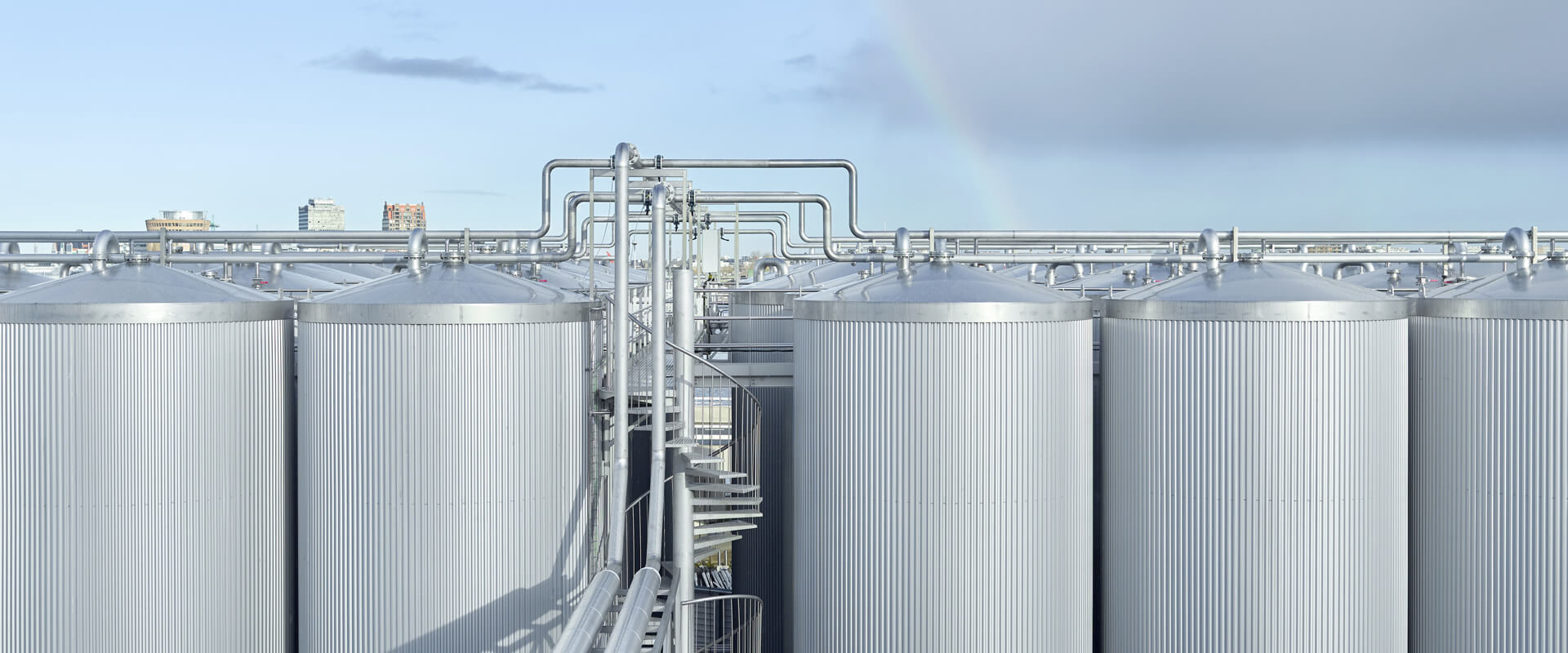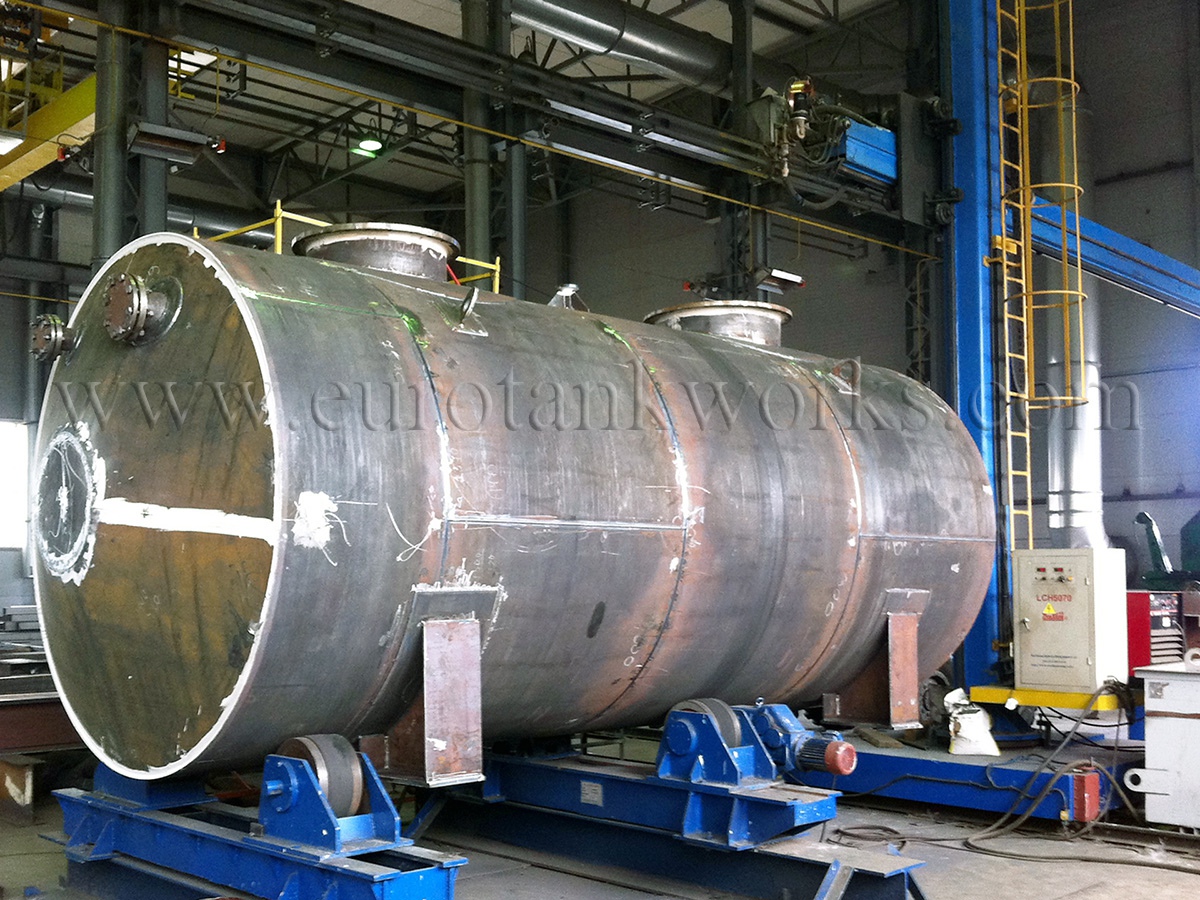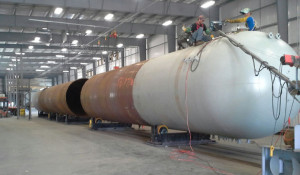How Oil & Gas Storage Tank Fabrication improves safety and compliance standards
The Future of Storage Tank Manufacturing: Fads and Technologies to Enjoy
The storage tank manufacturing industry gets on the cusp of a critical evolution, driven by arising trends in clever materials, automation, and sustainability. As industries progressively prioritize ecological responsibility, technologies such as green composites and IoT-driven surveillance systems are reshaping functional paradigms. Furthermore, the growing demand for personalization and modular designs recommends a shift in the direction of even more versatile production techniques. Recognizing these trends not only highlights the obstacles in advance but additionally exposes possibilities that could redefine the landscape of storage tank production in the coming years. What implications might these advancements hold for sector stakeholders?
Improvements in Smart Materials
Recently, the storage tank manufacturing field has witnessed a significant uptick in the fostering of smart products, transforming layout and performance. Smart materials, which can react dynamically to environmental adjustments, have made it possible for manufacturers to create storage tanks that are not just a lot more resilient however likewise more efficient in their functional capacities.
One remarkable development is the combination of form memory alloys and polymers that can adjust to varying pressures and temperatures. This adaptability boosts the architectural honesty of containers, lowering the threat of failures and leakages (Texas Oilfield Storage Tank Company). Furthermore, these materials typically display self-healing residential properties, which even more prolongs the life-span of storage space containers, decreasing upkeep expenses and enhancing safety
The unification of sensors within wise products permits for real-time monitoring of storage tank problems, providing important information that assists in predictive upkeep and threat management. This data-driven technique not just improves operational effectiveness but additionally aligns with environmental sustainability goals by maximizing source usage and preventing spills.
Rise of Automation Technologies
The rise of automation technologies is changing storage tank manufacturing by integrating robotics into production processes, improving efficiency and precision. In addition, the deployment of clever sensors makes it possible for real-time tracking, making certain high quality control and safety requirements are met. AI-driven process optimization further enhances procedures, minimizing costs and enhancing overall productivity in the industry.
Robotics Integration in Manufacturing
Robotics integration is transforming the manufacturing landscape, particularly in the storage tank sector. As manufacturers endeavor for raised performance and accuracy, robotics modern technologies are coming to be crucial devices for improving manufacturing procedures. Automated systems are capable of doing repeated tasks with better rate and accuracy than human labor, reducing the chance of mistakes and improving overall item top quality.
One of the key advantages of robot assimilation is the capability to maximize process. Automated robot arms can manage heavy materials, weld parts, and perform assessments, which lessens physical stress on workers and minimizes downtime. This change not just boosts security however also enables human workers to concentrate on even more complicated and value-added jobs.
Furthermore, robotics can help with flexible production, allowing firms to adapt quickly to altering market needs - Oil & Gas Storage Tank Fabrication. Advanced programs permits robots to quickly switch over between different jobs and items, which is particularly beneficial in a market where customization is progressively wanted
As robotics technology continues to evolve, manufacturers can anticipate improved capacities, consisting of improved device finding out formulas and augmented truth applications, additionally driving efficiency in storage tank production and setting new criteria for the industry.
Smart Sensors Deployment

Additionally, the data gathered from these sensing units can be leveraged to optimize the supply chain, making certain that materials are readily available when needed while lessening waste. This level of insight allows manufacturers to react quickly to altering problems and client demands, boosting general productivity.
Additionally, clever sensors add to enhanced regulatory conformity by continuously keeping an eye on environmental aspects and making sure adherence to safety requirements. As the market progresses in the direction of more sustainable practices, the capability to keep an eye on exhausts and source intake in real-time is indispensable.
AI-Driven Process Optimization
Manufacturers in the storage tank market are progressively taking advantage of the power of AI-driven procedure optimization to improve functional effectiveness and decision-making abilities. By integrating sophisticated algorithms and device discovering methods, firms can assess substantial quantities of information created throughout the production procedure. This data-driven strategy enables real-time monitoring of production metrics, resulting in more enlightened choices and prompt interventions.
AI technologies facilitate anticipating upkeep, enabling manufacturers to anticipate tools failures prior to they happen, thereby decreasing downtime and maintenance prices. Furthermore, these systems can maximize resource allotment by evaluating manufacturing patterns and readjusting operations, guaranteeing that materials and labor are made use of effectively.
Furthermore, AI-driven optimization enhances top quality control by determining prospective problems during the production process. Automated examinations powered by AI can quickly discover variances, ensuring that just items meeting stringent quality requirements progress with the production line.
As the storage tank market remains to accept automation, AI-driven procedure optimization sticks out as a transformative pressure, driving innovation and competitiveness. By leveraging these modern technologies, manufacturers can not only simplify procedures yet likewise adjust swiftly to market needs, placing themselves for lasting development in an increasingly complicated production landscape.
Concentrate On Sustainability Practices
As the storage tank manufacturing sector progresses, a substantial focus is put on sustainability methods. This consists of the fostering of environment-friendly materials, the execution of energy-efficient production procedures, and the assimilation of circular economic situation concepts. By focusing on these efforts, manufacturers not only reduce their ecological effect however also improve the longevity and performance of their products.
Environmentally Friendly Products Fostering
Progressively, the storage tank production market is accepting environmentally friendly products as a fundamental element of sustainability techniques. This shift is driven by heightened environmental recognition and regulatory stress, prompting manufacturers to look for options that decrease eco-friendly influence.
Recycled steels and biodegradable compounds are gaining traction, providing both efficiency and lower carbon impacts. Making use of high-recycled-content steel not just lowers the demand for virgin materials yet additionally improves the overall sustainability of the item lifecycle. Furthermore, manufacturers are exploring bio-based materials that give resilience while being much less hazardous to the setting.
In addition, the adoption of environment-friendly finishes and finishes, which are devoid of unpredictable natural compounds (VOCs), mirrors the sector's commitment to decreasing air pollution and promoting much healthier working conditions. These innovations not just align with international sustainability goals yet likewise satisfy the growing market need for greener products.
The assimilation of environmentally friendly products in storage tank manufacturing is not simply a fad; it represents a positive approach towards liable manufacturing that prioritizes both environmental stewardship and financial practicality, establishing a brand-new standard for future advancements in the sector.
Energy-efficient Manufacturing Processes
There is an expanding recognition within the storage tank manufacturing industry of the relevance of energy-efficient processes as a necessary part of sustainable practices. As the market deals with raising pressure to reduce its carbon footprint, manufacturers are carrying out cutting-edge modern technologies and approaches intended at lessening power intake throughout the manufacturing cycle.
One significant pattern is the fostering of advanced manufacturing methods such as lean production and automation. These strategies streamline procedures, lower waste, and enhance productivity, while likewise decreasing power usage. Additionally, the integration of renewable resource sources, such as solar and wind power, into manufacturing facilities is becoming extra widespread, permitting firms to run sustainably and lower dependancy on fossil gas.
Additionally, energy-efficient machinery and tools are being focused on in brand-new investments, as manufacturers seek to optimize their power intake. Making use of energy administration systems allows real-time tracking and analysis, assisting in constant enhancement in energy performance.
Round Economic Climate Integration
A noteworthy change towards round economic situation combination is transforming sustainability techniques within the storage tank manufacturing industry. This technique emphasizes the importance of source performance, waste decrease, and the recycling of materials throughout the production lifecycle. By adopting circular concepts, manufacturers are progressively focused on developing tanks that focus on recyclability, repairability, and longevity.
As part of this adjustment, firms are checking out innovative materials and manufacturing techniques that anchor decrease environmental influence. The consolidation of recycled steels and plastics not only minimizes the need for virgin resources yet also reduces carbon exhausts connected with removal and handling. Additionally, manufacturers are carrying out take-back systems that help with the refurbishment and recycling of end-of-life storage tanks, therefore closing the loophole in the manufacturing cycle.
Partnership among stakeholders, consisting of consumers and providers, is important for promoting a round economy (Storage Tank Manufacturing). This partnership makes it possible for the sharing of ideal practices and encourages the development of lasting supply chains. Inevitably, incorporating circular economic climate principles right into storage tank manufacturing not only boosts environmental stewardship however also settings business to meet evolving governing criteria and consumer expectations for sustainability
Boosted Safety And Security Procedures
In today's production landscape, boosted safety protocols have actually become vital for storage tank manufacturers. The market faces raising governing examination and demands for greater security requirements as a result of the prospective dangers connected with the storage of harmful materials. Manufacturers are adopting a multifaceted technique to boost safety steps throughout the production procedure.
One substantial advancement is the application of innovative threat assessment devices that identify prospective hazards during the design and manufacturing phases. These devices help with aggressive steps to reduce risks before they escalate into vital concerns. Manufacturers are spending in employee training programs that highlight safety and security techniques, assuring that all employees are fluent in emergency situation procedures and equipment handling.
Furthermore, there is a growing emphasis on the usage of top quality products and ingenious designs that enhance architectural integrity and reduce the possibility of failures or leaks. Routine upkeep checks and extensive screening procedures are likewise being integrated into the production lifecycle to guarantee conformity with safety and security policies.
Integration of IoT Solutions

IoT devices assist in predictive maintenance, which decreases downtime and extends the life-span of storage space tanks. By evaluating data accumulated from sensors, manufacturers can predict potential failures and execute upkeep tasks before vital problems emerge. This positive method not just conserves costs yet additionally assures conformity with safety and security policies.
Additionally, IoT combination sustains much better supply management by giving precise, real-time data on saved products. Texas Oil & Gas Storage Tank Fabrication Authority. This ability assists manufacturers maximize their supply chains, guaranteeing that needed sources are readily available when required, consequently enhancing general productivity
The application of IoT remedies makes it possible for enhanced interaction between storage tanks and central management systems, improving procedures. As the storage tank manufacturing sector remains to embrace IoT innovations, we can anticipate significant developments in security methods and functional performances, inevitably leading to even more resilient manufacturing methods.
Personalization and Modular Style
Versatility in style has actually become a cornerstone of modern storage tank production as modification and modular style alternatives gain traction. The evolving requirements of industries such as oil and gas, chemicals, and water monitoring require tailored services that accommodate details operational needs. Personalization enables manufacturers to produce tanks that satisfy one-of-a-kind specs regarding dimension, shape, material, and capability, ensuring peak efficiency and effectiveness.
Modular design, on the other hand, enables for the setting up of pre-fabricated components, leading to substantial time and cost savings. This technique facilitates rapid implementation and scalability, allowing businesses to adapt their storage abilities in feedback to fluctuating demand. Furthermore, modular systems can be quickly increased or reconfigured, decreasing downtime and enhancing operational flexibility.
The combination of sophisticated manufacturing innovations, such as 3D printing and computer-aided style (CAD), more boosts modification opportunities. These developments allow exact design and rapid prototyping, enabling quick adjustments and iterations during the design process.

Regulative Changes and Conformity
Regulatory adjustments and compliance needs frequently form the landscape of storage tank manufacturing, engaging manufacturers to stay versatile and alert. With increasing ecological issues and the promote sustainable methods, regulatory bodies are applying stricter standards worrying emissions, materials, and safety and security criteria. The United state Environmental Protection Company (EPA) and different state firms are revising policies that regulate the style and installment of storage space tanks, especially those made use of for hazardous materials.
Manufacturers have to not only conform with existing laws but also expect future modifications, demanding recurring investment in research study and advancement. This consists of taking on innovative materials and technologies that improve tank stability and environmental management. In addition, conformity with regulations such as the Spill Prevention, Control, and Countermeasure (SPCC) rule is crucial for manufacturers to avoid substantial penalties and lawful responsibilities.
In addition, the assimilation of electronic modern technologies assists in conformity tracking and reporting, making it possible for manufacturers to preserve transparency and performance. As guidelines continue to develop, remaining educated and positive is vital for storage tank manufacturers to ensure conformity, secure public health and wellness, and protect the setting, eventually shaping an extra sustainable industry.
Often Asked Concerns

What Are one of the most Typical Materials Made Use Of in Storage Tank Manufacturing?
The most usual materials made use of in storage tank manufacturing consist of carbon steel, stainless-steel, and fiberglass. Each material uses distinct advantages, such as sturdiness, corrosion resistance, and flexibility to different storage space demands and ecological conditions.
Just How Do Tank Impact Resident Ecosystems Throughout Setup?
Storage space tank installment can disrupt regional ecological communities by modifying land use, affecting water drain patterns, and potentially introducing toxins. Proper website analyses and environmental monitoring practices are vital to reduce these effects and shield biodiversity.
What Is the Ordinary Life-span of a Modern Storage Tank?
The average life expectancy of a contemporary storage tank commonly ranges from 20 to 30 years. Elements such as material high quality, ecological problems, and upkeep techniques considerably affect long life and total efficiency throughout their functional life-span.
How Do Manufacturers Guarantee Quality Assurance in Production?
Manufacturers assure quality control with strenuous testing protocols, adherence to market criteria, and continuous tracking throughout manufacturing (Oil & Gas Storage Tank Fabrication). Advanced innovations such as automation and real-time information evaluation better enhance uniformity and reliability in storage tank manufacturing procedures
What Are the Expenses Related To Maintaining Tank?
Maintaining storage space tanks entails numerous costs, including regular inspections, fixings, regulatory compliance, deterioration avoidance, and potential environmental removal. These expenditures can greatly influence general operational spending plans and necessitate proactive administration to ensure long-lasting efficiency and safety.
As manufacturers increasingly welcome automation technologies, the release of wise sensing units is becoming an essential facet of modern-day production procedures in the storage container market. Manufacturers in the storage container industry are significantly taking advantage of the power of AI-driven process optimization to boost operational efficiency and decision-making capacities. Progressively, the storage space tank production industry is welcoming environment-friendly materials as a basic aspect of sustainability techniques. In today's manufacturing landscape, boosted safety procedures have come to be critical for storage container manufacturers. Regulative adjustments and compliance needs frequently form the landscape of storage container manufacturing, engaging manufacturers to remain versatile and watchful.